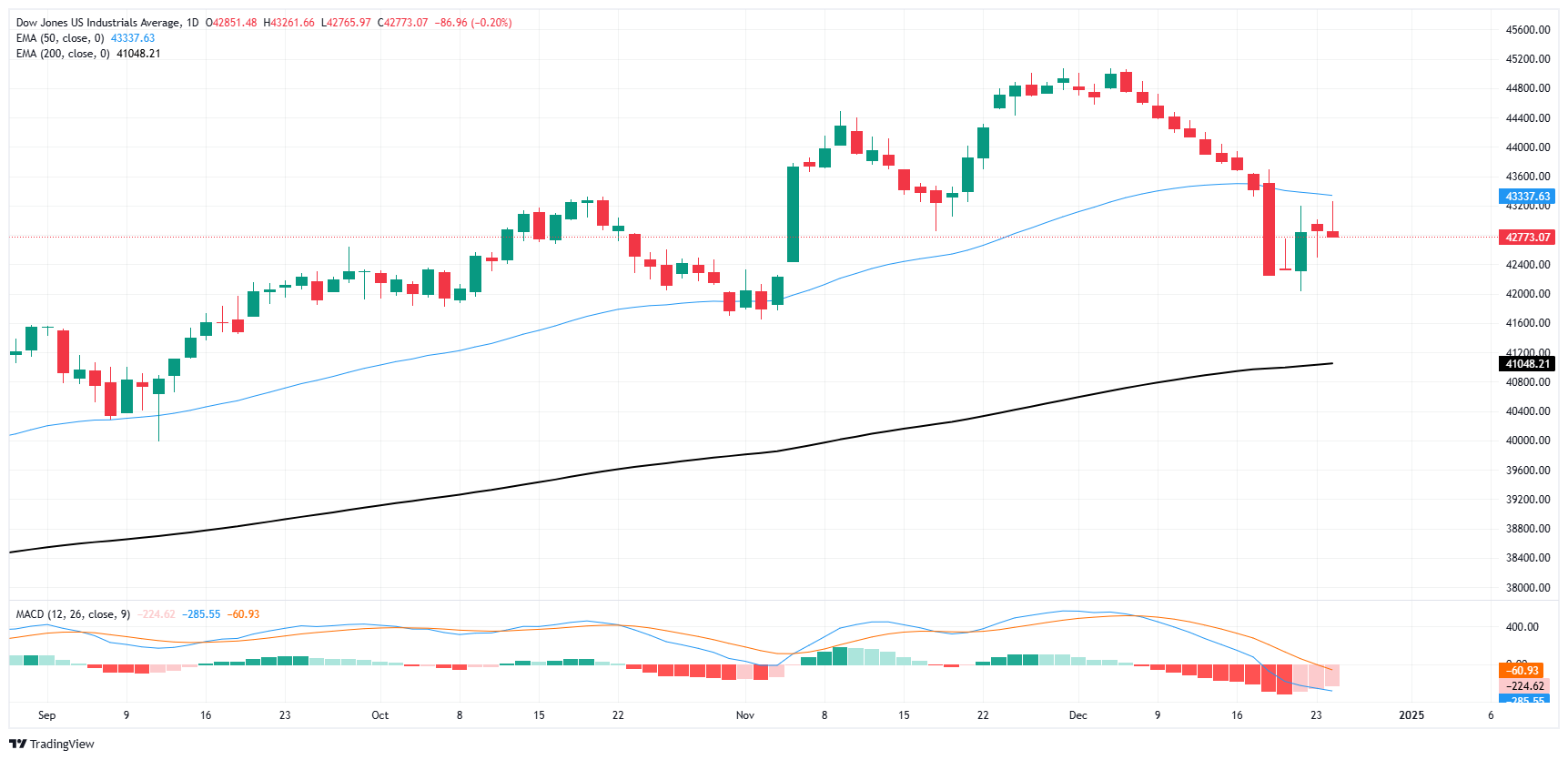- The Dow Jones lost 400 points on Friday.
- Holiday markets traded lower, the Dow finished the week flat.
- Another mid-week holiday next week will reduce market volumes.
The Dow Jones Industrial Average (DJIA) lost around 400 points on a quiet Friday. Most investors are still out of the markets for the holidays and low volumes have left the Dow Jones about a percentage point lower.
Holiday market flows are in full swing in equities, with a widespread cooling effect on the long-term tech rally as investors exit their positions and do some light profit-taking before the turn of the year. A thin data release schedule this week, followed by another mid-week holiday next week, leaves stock indices on a tepid note in the near term.
Traders are still grappling with the Federal Reserve’s (Fed) recent pivot toward expectations of fewer rate cuts in 2025 than previously expected. According to the Fed’s latest Summary of Economic Projections (SEP), policymakers only expect two more quarter-point cuts over the next year, hampering market expectations for a steeper rate drop. main reference.
Dow Jones News
Despite a generally windy year that saw the Dow Jones rise nearly 21.5% from the bottom to the top, the major stock index still got coal in its stocking as December heads deeper into the red and trims strong gains November. All but five of the stocks listed on the Dow are testing in the red on Friday, with losses led by Nvidia (NVDA), which fell more than 2% and is back below $137 per share.
Nvidia appears to have brushed aside recent reports that its latest AI-focused Blackwell chipset may have experienced an overheating issue, but fresh concerns have emerged for the AI-powered tech rally as investors weigh the possibility of tighter restrictions. on Chinese access to US-made silicon solutions A disproportionate amount of Chinese demand for newly developed AI-focused chipsets could leave Nvidia’s profit expectations in limbo if regulations hamper trade.
Dow Jones Price Forecast
The Dow Jones’ spectacular run in 2024 appears to be taking a pause after falling for three consecutive weeks. The DJIA is down almost 5% from all-time highs above 45,000, testing the waters just south of the 43,000 level.
The Dow Jones has fallen below its 50-day exponential moving average (EMA) near 43.345 for the second time in as many months, but the price action still holds well above the 200-day EMA near 40.960 after that the offers will find technical support near 42,000.
Dow Jones Daily Chart
Dow Jones FAQs
The Dow Jones Industrial Average, one of the world’s oldest stock indices, is made up of the 30 most traded securities in the United States. The index is weighted by price rather than capitalization. It is calculated by adding the prices of the securities that comprise it and dividing them by a factor, currently 0.152. The index was founded by Charles Dow, also founder of the Wall Street Journal. In recent years it has been criticized for not being sufficiently representative, since it only follows 30 companies, unlike broader indices such as the S& P 500.
There are many factors that drive the Dow Jones Industrial Average (DJIA). The main one is the aggregate performance of its component companies, revealed in quarterly corporate earnings reports. US and global macroeconomic data also contribute, influencing investor sentiment. The level of interest rates, set by the Federal Reserve (Fed), also influences the DJIA, as it affects the cost of credit, on which many companies largely depend. Therefore, inflation can be a determining factor, as well as other parameters that influence the Federal Reserve’s decisions.
The Dow Theory is a method for identifying the main trend of the stock market developed by Charles Dow. A key step is to compare the direction of the Dow Jones Industrial Average (DJIA) and the Dow Jones Transportation Average (DJTA) and only follow trends where they are both moving in the same direction. Volume is a confirmation criterion. The theory uses elements of maximum and minimum analysis. The Dow theory proposes three phases of the trend: accumulation, when the smart money begins to buy or sell; public participation, when the general public joins the trend; and distribution, when the smart money abandons the trend.
There are several ways to trade the DJIA. One of them is to use ETFs that allow investors to trade the DJIA as a single security, instead of having to buy shares of the 30 companies that comprise it. A prominent example is the SPDR Dow Jones Industrial Average ETF (DIA). Futures contracts on the DJIA allow traders to speculate on the future value of the index, and options provide the right, but not the obligation, to buy or sell the index at a predetermined price in the future. Mutual funds allow investors to purchase a portion of a diversified portfolio of DJIA securities, providing exposure to the global index.
Source: Fx Street
I am Joshua Winder, a senior-level journalist and editor at World Stock Market. I specialize in covering news related to the stock market and economic trends. With more than 8 years of experience in this field, I have become an expert in financial reporting.







